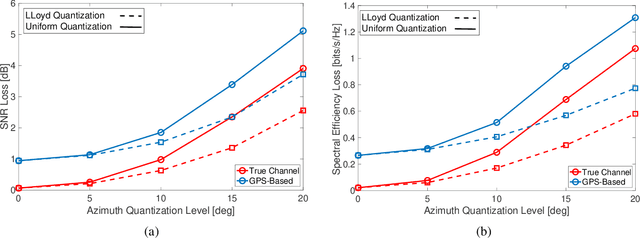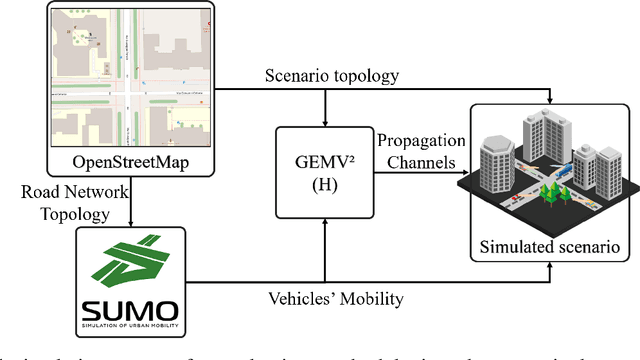Majid Nasiri Khormuji
Signal Constellation Construction via Radio Frequency Mirrors
Dec 24, 2024Abstract:By integrating feedback with Radio Frequency (RF) mirrors, we develop a closed-loop media-based modulation system for efficient utilization of the signal space. Specifically, this closed-loop construction optimizes the inherited signal constellation from the media, achieving a significantly larger minimum pairwise Euclidean distance than the original configuration. The initial signal constellation, derived from the media, is used to compute a set of complex weights for all activation patterns of the RF mirrors. These complex weights are then fed back to the transmitter to refine the transmit signal before it reaches the mirrors. This feedback mechanism ensures that the received, shaped signal constellation retains improved properties, enabling more reliable transmission. Notably, the closed-loop approach enables the media-based modulation to approach the performance of an AWGN channel, while the channel from each mirror to the single-antenna receiver is modeled as Rayleigh fading.
Multi-Modal Concurrent Transmission
Feb 09, 2024Abstract:This paper introduces a novel physical-layer method labelled as Multi-Modal Concurrent Transmission (MMCT) for efficient transmission of multiple data streams with different reliability-latency performance requirements. The MMCT arranges data from multiple streams within a same physical-layer transport block wherein stream-specific modulation and coding scheme (MCS) selection is combined with joint mapping of modulated codewords to Multiple-Input Multiple-Output spatial layers and frequency resources. Mapping to spatial-frequency resources with higher Signal-to-Noise Ratios (SNRs) provides the required performance boost for the more demanding streams. In tactile internet applications, wherein haptic feedback/actuation and audio-video streams flow in parallel, the method provides significant SNR and spectral efficiency enhancements compared to conventional 3GPP New Radio (NR) transmission methods.
* 6 pages, 4 figures, 1 table
Spatial-Interference Aware Cooperative Resource Allocation for 5G NR Sidelink Communications
Nov 15, 2021



Abstract:Distributed resource allocation (RA) schemes have been introduced in cellular vehicle-to-everything (C-V2X) standard for vehicle-to-vehicle (V2V) sidelink (SL) communications to share the limited spectrum (sub-6GHz) efficiently. However, the recent progress in connected and automated vehicles and mobility services requires a huge amount of available spectrum resources. Therefore, millimeter-wave and sub-THz frequencies are being considered as they offer a large free bandwidth. However, they require beamforming techniques to compensate for the higher path loss attenuation. The current fifth-generation (5G) RA standard for SL communication is inherited from the previous C-V2X standard, which is not suited for beam-based communication since it does not explore the spatial dimension. In this context, we propose a novel RA scheme that addresses the directional component by adding this third spatial dimension to the bandwidth part structure and promotes cooperation between vehicles in resource selection, namely cooperative three-dimensional RA. Numerical results show an average of 10% improvement in packet delivery ratio, an average 50% decrease in collision probability, and a 30% better channel busy ratio compared to the current standard, thus, confirming the validity of the proposed method.
LoS-Map Construction for Proactive Relay of Opportunity Selection in 6G V2X Systems
Nov 15, 2021



Abstract:The evolution of connected and automated vehicles (CAVs) technology is boosting the development of innovative solutions for the sixth generation (6G) of Vehicular-to-Everything (V2X) networks. Lower frequency networks provide control of millimeter waves (mmWs) or sub-THz beam-based 6G communications. In CAVs, the mmW/Sub-THz guarantees a huge amount of bandwidth (>1GHz) and a high data rate (> 10 Gbit/s), enhancing the safety of CAVs applications. However, high-frequency is impaired by severe path-loss, and line of sight (LoS) propagation can be easily blocked. Static and dynamic blocking (e.g., by non-connected vehicles) heavily affects V2X links, and thus, in a multi-vehicular case, the knowledge of LoS (or visibility) mapping is mandatory for stable connections and proactive beam pointing that might involve relays whenever necessary. In this paper, we design a criterion for dynamic LoS-map estimation, and we propose a novel framework for relay of opportunity selection to enable high-quality and stable V2X links. Relay selection is based on cooperative sensing to cope with LoS blockage conditions. LoS-map is dynamically estimated on top of the static map of the environment by merging the perceptive sensors' data to achieve cooperative awareness of the surrounding scenario. Multiple relay selection architectures are based on centralized and decentralized strategies. 3GPP standard-compliant simulation is the framework methodology adopted herein to reproduce real-world urban vehicular environments and vehicles' mobility patterns.
Fastening the Initial Access in 5G NR Sidelink for 6G V2X Networks
Jun 10, 2021



Abstract:The ever-increasing demand for intelligent, automated, and connected mobility solutions pushes for the development of an innovative sixth Generation (6G) of cellular networks. A radical transformation on the physical layer of vehicular communications is planned, with a paradigm shift towards beam-based millimeter Waves or sub-Terahertz communications, which require precise beam pointing for guaranteeing the communication link, especially in high mobility. A key design aspect is a fast and proactive Initial Access (IA) algorithm to select the optimal beam to be used. In this work, we investigate alternative IA techniques to fasten the current fifth-generation (5G) standard, targeting an efficient 6G design. First, we discuss cooperative position-based schemes that rely on the position information. Then, motivated by the intuition of a non-uniform distribution of the communication directions due to road topology constraints, we design two Probabilistic Codebook (PCB) techniques of prioritized beams. In the first one, the PCBs are built leveraging past collected traffic information, while in the second one, we use the Hough Transform over the digital map to extract dominant road directions. We also show that the information coming from the angular probability distribution allows designing non-uniform codebook quantization, reducing the degradation of the performances compared to uniform one. Numerical simulation on realistic scenarios shows that PCBs-based beam selection outperforms the 5G standard in terms of the number of IA trials, with a performance comparable to position-based methods, without requiring the signaling of sensitive information.
 Add to Chrome
Add to Chrome Add to Firefox
Add to Firefox Add to Edge
Add to Edge